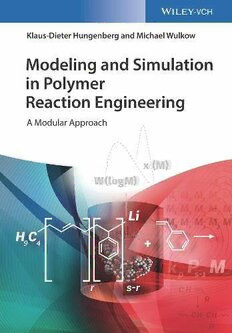Table Of ContentModelingandSimulationinPolymer
ReactionEngineering
Modeling and Simulation in Polymer
Reaction Engineering
AModularApproach
Klaus-DieterHungenbergandMichaelWulkow
Authors AllbookspublishedbyWiley-VCHare
carefullyproduced.Nevertheless,authors,
Prof.Klaus-DieterHungenberg editors,andpublisherdonotwarrantthe
Ortsstrasse135 informationcontainedinthesebooks,
69488Birkenau includingthisbook,tobefreeoferrors.
Germany Readersareadvisedtokeepinmindthat
statements,data,illustrations,procedural
detailsorotheritemsmayinadvertently
Dr.MichaelWulkow
beinaccurate.
Harry-Wilters-Ring27
26180Rastede LibraryofCongressCardNo.:appliedfor
Germany
BritishLibraryCataloguing-in-Publication
CoverimagewasprovidedbyLisaKulot Data
Acataloguerecordforthisbookis
availablefromtheBritishLibrary.
Bibliographicinformationpublishedby
theDeutscheNationalbibliothek
TheDeutscheNationalbibliothek
liststhispublicationintheDeutsche
Nationalbibliografie;detailed
bibliographicdataareavailableonthe
Internetat<http://dnb.d-nb.de>.
©2018Wiley-VCHVerlagGmbH&Co.
KGaA,Boschstr.12,69469Weinheim,
Germany
Allrightsreserved(includingthoseof
translationintootherlanguages).Nopart
ofthisbookmaybereproducedinany
form–byphotoprinting,microfilm,or
anyothermeans–nortransmittedor
translatedintoamachinelanguage
withoutwrittenpermissionfromthe
publishers.Registerednames,trademarks,
etc.usedinthisbook,evenwhennot
specificallymarkedassuch,arenottobe
consideredunprotectedbylaw.
PrintISBN:978-3-527-33818-4
ePDFISBN:978-3-527-68575-2
ePubISBN:978-3-527-68574-5
MobiISBN:978-3-527-68576-9
oBookISBN:978-3-527-68573-8
CoverDesign Grafik-DesignSchulz,
Fußgönheim,Germany
Typesetting SPiGlobal,Chennai,India
PrintingandBinding
Printedonacid-freepaper
10 9 8 7 6 5 4 3 2 1
v
Contents
Preface ix
1 Introduction 1
1.1 SpecialFeaturesofPolymers 1
1.2 StructuresinPolymersandTheirInfluenceonProcessingand
ApplicationProperties 3
1.2.1 ChainLength,MolecularMass,Moments,andMeanValues 3
1.2.2 RheologicalProperties 6
1.2.3 ConstitutionalIsomers 7
1.2.4 ArchitecturalIsomers 9
1.2.5 Copolymers 11
1.3 SomeAnalyticalMethodsforModelValidation 13
1.4 DescriptionofPolymerProperties 15
1.4.1 ChemicalMasterEquations 17
1.4.2 ApproachestoPolymerProperties 21
1.4.3 StochasticandDeterministicSimulation 22
2 PolymerReactions 25
2.1 ModuleConcept 25
2.2 RateCoefficientsinPolymerizationReactions 26
2.3 BuildingMacromolecules 28
2.4 OnlyChain-FormingReactionsTakePlace,Step-Growth
Polymerization 30
2.4.1 OnlyOneTypeofEndGroup:TheA−ACase,AReacting
withA 31
2.4.2 TwoTypesofFunctionalGroupsAandBatOneMolecule;AReacts
withB 40
2.4.3 IntroducingMonofunctionalMoleculestoControlDegreeof
Polymerization 41
2.4.4 AdditionofaSecondBifunctionalMonomer,TwoFunctionalGroups
onTwoDifferentMolecularSpecies 43
2.4.5 ReversibleReactions 49
2.5 Chain-GrowthPolymerization–InitiationRequired 58
2.5.1 LivingPolymerization–OnlyInitiationandPropagation(Chain
Growth)TakePlace 59
vi Contents
2.5.1.1 MomentEquations 65
2.5.2 LivingPolymerizationTogetherwithChainDepropagation 68
2.5.3 InitiationandChainGrowthwithTransferReactions 75
2.5.4 InitiationandChainGrowthwithDeactivation 76
2.5.5 InitiationandChainGrowthwithChainTermination 77
2.5.5.1 TerminationbyDisproportionation 84
2.5.5.2 TerminationbyCombination 84
2.5.5.3 TransfertoMonomerorTransferAgent 86
2.5.5.4 TransfertoPolymer 87
2.5.5.5 PropagationwithChangeofCharacteristics 89
2.5.5.6 𝛽-Scission 90
2.6 Copolymerization 91
2.6.1 ConventionalDescriptionofCopolymerComposition 91
2.6.2 CharacteristicValuesfortheCharacterizationof
Copolymers 94
2.6.3 ModulesfortheDescriptionofCopolymerization 97
2.6.4 ExtendedDescriptionofaCopolymer 101
2.6.5 DistributedCounters 104
2.7 NonlinearPolymerization 106
2.7.1 Branching;GraftPolymersviaCopolymerization,
(Graftingthrough) 106
2.7.2 Cross-LinkingviaCopolymerization 107
2.7.3 NonlinearStructuresbyPolymerizationfromanExistingChain,
Graftingfrom 109
2.7.4 Cross-LinkingofPreformedLinearMacromoleculesby
Low-Molecular-MassCompounds 111
2.7.5 NonlinearStepGrowth 111
2.7.6 HigherDimensionalModels 113
2.8 ListofModules 114
2.8.1 ElementalKinetic 115
2.8.2 Combination(P,Q,T,A) 116
2.8.3 StatisticalDegradation(P,Q,T,A,B) 119
2.8.4 ChangeofCharacteristics(P,Q,A,B) 120
2.8.5 IntermolecularTransfer(P,Q,T,R,A) 121
2.8.6 CrossTransfer(P,Q,T,R,A) 123
2.8.7 Initiation(P,A,B,C,m) 124
2.8.8 Propagation(P,Q,M,A,m) 125
2.8.9 Depropagation(P,Q,M,A,B,m) 127
2.8.10 Transfer(P,Q,T,M) 128
2.8.11 Disproportionation(P,Q,R,T,A) 129
2.8.12 TransfertoPolymer(P,Q,T,R,A) 131
2.8.13 Scission(P,Q,T,A,B) 132
2.8.14 Cross-Linking(P,Q,T,A) 133
2.8.15 Flow(A ,A ) 134
1 2
2.8.16 PhaseTransfer(A ,A ) 135
1 2
2.8.17 ExampleSystem 135
Contents vii
3 ReactorsforPolymerizationProcesses 139
3.1 Introduction 140
3.2 Well-Mixed(Ideal)BatchReactor(BR) 141
3.2.1 AspectsoftheOverallMassBalance 143
3.2.2 HeatBalanceinaBatchReactor 144
3.2.3 PolymerPropertiesinBatchReactors 148
3.3 Semi-BatchReactor(Semi-BR) 149
3.4 TheContinuousStirredTankReactor(CSTR) 151
3.4.1 HomogeneousContinuousStirredTankReactor(HCSTR) 151
3.4.2 CascadeofHCSTR 156
3.4.3 SegregatedContinuousStirredTankReactor(SCSTR) 157
3.5 TubularReactors 158
3.5.1 PlugFlowReactor(PFR) 158
3.5.2 LaminarTubularReactor 159
3.6 NonidealReactorModelswithPartialBackmixing 159
3.7 ComparisonofReactors 161
4 PhasesandPhaseTransitions 163
4.1 TreatmentofVolumesandConcentrations 164
4.2 PhaseTransferModules 165
4.2.1 Two-FilmTheory 166
4.2.2 ExamplesforPhaseTransferSteps 169
4.2.2.1 EvaporationofaPureVolatileCompound 169
4.2.2.2 Vapor–LiquidEquilibriumofVolatileCompounds 170
4.2.2.3 AdsorptionofGaseousCompounds 170
4.2.2.4 VaporPressureAboveaPolymerSolution 172
4.2.2.5 DemixinginPolymerSolutions 174
4.2.3 Example:PhaseTransferDuringPolymerization;LivingAnionic
PolymerizationofButadiene 175
4.2.4 SummarizingRemarkstothePhaseChangeModule 178
4.3 MultiphasePolymerizationSystems 179
4.3.1 SuspensionPolymerization 179
4.3.2 Precipitation/DispersionPolymerization 180
4.3.3 EmulsionPolymerization 181
5 NumericalMethods 193
5.1 Introduction 193
5.2 OrdinaryDifferentialEquations 195
5.2.1 ConsistencyandConvergence 195
5.2.2 Stability 197
5.2.3 ErrorControl 200
5.2.4 APracticalGuidetoODESolvers 205
5.2.4.1 ListofExplicitMethodsandSolversforNon-StiffODEs 206
5.2.4.2 ListofImplicitMethodsandSolversforStiffODEsandDifferential
AlgebraicEquations(DAEs) 206
5.3 CountableSystemsofOrdinaryDifferentialEquations–CODEs 208
5.3.1 TheoreticalAspects 208
viii Contents
5.3.2 TheChain-LengthRange 209
5.3.3 InitializationofPolymerDistributions 211
5.3.4 ApproximationSchemes 212
5.4 EstimatingtheNumericalError 217
5.5 MonteCarloMethods 220
5.6 TheModelingCycle:DealingwithDifferentErrors 223
6 ParameterEstimation 227
6.1 Introduction:ForwardandInverseProblems 227
6.2 GeneralTheory 230
6.2.1 Introduction 230
6.2.2 TheMinimizationProblem 232
6.2.3 SensitivityAnalysis 235
6.3 CorrelatedParameters 236
6.3.1 Damping 237
6.3.2 EssentialDirections 238
6.4 Example:ParameterDependenciesandCondition 240
7 StyreneButadieneCopolymers 251
7.1 ModelDescription 251
7.2 ComponentsoftheModel 251
7.2.1 Low-Molecular-WeightCompounds 251
7.2.2 PolymerDistributions 252
7.2.3 SequenceDistributions 253
7.2.4 Counters 253
7.2.5 ComputationofCharacteristicValuesforCopolymersfrom
Counters 254
7.3 ReactionModules 254
7.3.1 ChainInitiation 254
7.3.2 ChainPropagation 255
7.3.3 LiH-Elimination 256
7.3.4 ChainTransfer 256
7.3.5 Re-Initiationby1-Phenyl-1-LithiumEthane 257
7.3.6 BalanceSteps 257
7.4 ExemplarySimulations 258
7.5 ExemplificationoftheModelingCyclefortheStyrene–Butadiene
Example 266
References 269
Appendix 277
Index 283
ix
Preface
Syntheticpolymershaveanoverwhelmingimportanceinourworld.Moreover,
this does not just mean the economic importance but also the role synthetic
polymers play to overcome the challenges and trends in our world. Polymers
help meet the customer’s key needs in transportation, energy, housing, health,
andsoon.Tofulfillthesechallenges,polymersmustbetailoredtothespecific
needsintheirfinalapplication.Thecrucialtaskisthecombinationofthecorrect
chemistryandthebestprocessinordertolinkthemonomerunitstoobtainan
appropriatemicrostructureofthepolymer:composition,chainlengths,branch-
ing,andsoon,aswellastheirrespectivedistributions.
Mathematicalmodelshave,foralongtime[1,2],helpeddescribetheinterde-
pendencybetweentheformationofmacromoleculesandtheirresultingstructure
inaquantitativemannerandthusmayhelptheproductdevelopingchemistin
thelaboratorywhendesigninganewpolymeraswellasthechemicalengineer
whendesigningaplant.Moreover,modelsmayserveasalinkbetweenboth.
Thus, the book addresses the interest of both chemists and engineers, those
whoarealreadyadvancedpractitioners,andalsostudentsandthosestartingon
thetopicofpolymerizationprocessmodeling.
However,withthisbookwedonotwanttosupplythereaderwithready-to-use
modelsforvariouscases,buttoenablehimorhertosetupownmodelssuitableto
solvespecificproblems.Forthispurpose,wefollowamodular,unifyingapproach
whichdiffersfrommostoftheworkdoneinthisfieldinthepast.
Foreverypolymerizationmechanism,separatemodelsundercertainassump-
tionsandrestrictionshavebeendevelopedandsuccessfullyused.So,modelsfor
step-growth polymerization (see Section 2.4) for the description of polyesters,
polyamides, polyurethanes, and so on, are in many cases restricted to yield
averagesandmomentsofthemolecularmassdistribution(MWD)byassuming
thevalidityofthemostprobableSchulz–Florydistributionforthecomputation
of the MWD. For the large class of chain-growth polymerization (see Section
2.5),thereexistdifferentmodelsforionicpolymerization,livingpolymerization,
radicalpolymerization,transition-metal-catalyzedpolymerization,andsoforth.
Allofthemneedcertainassumptions.Eventheratioofratecoefficientscauses
different ways to solve for the MWD. In the case of living anionic polymeriza-
tion (see Section 2.5.1), this results in either a Poisson or the so-called Gold
distribution depending on the ratio of initiation and propagation coefficient.
In radical polymerization and copolymerization, a steady-state approximation
x Preface
for the active species is often assumed. Models for heterogeneous processes
likeemulsion,dispersion,orprecipitationpolymerizationformanotherclassof
modelsthatusuallydifferintheassumptionsformasstransfersteps.
To overcome the limitations of these case-by-case models, we introduce a
modular approach. By this, reaction schemes of typical polymer reactions will
be designed by a combination of a set of elementary reaction steps [2] and
the corresponding rate equations. These reaction schemes will be put into any
kindofreactorsandtheircompartmentsandphases,wherethetransportrates
for mass and energy between these compartments are again described by rate
modules.
InChapter1–asakindofappetizer–weaddresssomespecialfeaturesofpoly-
merstructuresandprocessescomparedtolowmolecularcompounds,andgive
some examples for the dependence of application properties on the molecular
structureandsomehintstoanalyticalmethodstogetaninsightintothemolec-
ularstructurewewanttodescribewithourmodels.Moreover,weintroducethe
principles of deterministic modeling using differential-algebraic equations and
stochasticmodelingusingMonteCarlomethods.
Chapters 2 to 4 are devoted to model building using this modular approach.
Here, model building means the translation of the expert knowledge of the
chemistorengineeraboutthereactionmechanism,thekineticsandthermody-
namics,andthereactorintomathematicalequationstoquantifythisknowledge.
Chapter 2 describes the modules for the elementary reaction steps used to
describe polymer reactions. Even though not necessary, in many cases we link
themodulestothemoreconventionaldescriptiontofamiliarizethereaderwith
this concept. With some examples the link between kinetics and structure is
demonstrated.
InChapter3,reactormodulesarederivedwithspecialemphasisonheatand
massbalancesandresidencetimedistribution,togetherwithsomeinsightinto
howstructuralpropertiesofthepolymersdependontheresidencetimedistri-
butionofthereactor.
The use of different phases and the transport between them is described in
Chapter 4together with some simple chemical engineering approaches for the
phasetransferingeneral,andhowtheseprinciplescanbeappliedtomultiphase
polymersystemslikesuspension,precipitation,oremulsionpolymerization.
Afterhavingsetupthemodel,weneedmethodstosolvetheequations.These
are described in Chapter 5. However, this chapter does not describe the vari-
ousmethodstosolveordinaryorpartialdifferentialequationsinalldetail,but
highlightssomegenerallyimportantaspectslikeconvergence,stability,anderror
control,andtriestogivesomehintstodetecterrors.Wealsodirecttheusersto
deterministic(Section5.3)andstochasticalsolutions(Section5.5)ofthespecial
equationsrelatedtopolymerkinetics.
Essential for the quality of the modeling results is the quality of the model
parameters.So,inChapter6 theproblemofparameterestimationisdiscussed
especiallyinviewoftheill-posednatureoftheunderlyinginverseproblemand
thedependencyofparameters.Anillustrativeexampleshowshowthenumber
andkindofmeasurementsusedfortheestimationinfluencesthequalityofthe
parameters.
Preface xi
Fortheexecutionofamodelingproject,weproposetofollowamodelingcycle
(Section5.6)tocapturepossiblenumericalandmodelingerrorsinthemodel.
AdetailedexamplesysteminChapter7demonstratesthevariousaspectsand
techniquesofmodelingpolymerizationreactions.
Wehopethatthesetechniquesforcethereadertosetuphisorherownmodels
and simulations to solve specific problems, and so we explicitly abstain from a
chapteronoptimization.
Klaus-DieterHungenberg
Birkenau,Germany
MichaelWulkow
2017 Rastede,Germany

